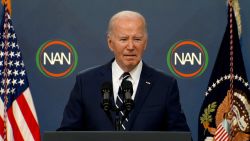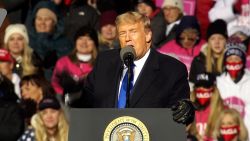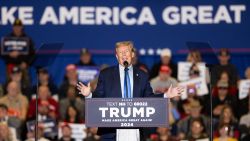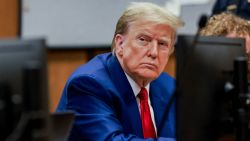Let’s start with what we know almost for sure – the Senate’s impeachment trial of President Donald Trump is likely to end with his acquittal. Conviction would require 20 Republicans to side with Democrats, and at the moment, there’s no sign that any Republican senators are ready to vote to remove Trump from office.
Other than that, we know the Senate, according to the Constitution, must hold a trial after the House impeaches Trump. There are formal rules in place – 26 of them, although a simple majority of 51 senators can vote to change any of the rules at any time. Read the full rules here – or read the highlights below:
1. The rules were first written for the Senate trial of Andrew Johnson
Those 1868 rules, which seem baroque today, were updated by the Senate for modern use after Watergate, even though President Richard Nixon resigned in 1974 rather than wait for Congress to impeach him. The most recent updates were completed in 1986, according to the Senate historian’s website. They were used for Bill Clinton’s trial in 1999, but the basics still stem from what was written to guide senators through Johnson’s impeachment during Reconstruction.
The same rules have also been used for a number of federal judges who have been impeached. One of those judges, Alcee Hastings, became a congressman after he was impeached and removed from office. He supports impeaching Trump.
2. The sessions are choreographed in a very specific way
In Rule II, for instance, there is a script for how the House tells the Senate that someone has been impeached:
“The Presiding Officer of the Senate shall direct the Sergeant at Arms to make proclamation who shall, after making proclamation, repeat the following words, viz: ‘All persons are commanded to keep silence, on pain of imprisonment, while the House of Representatives is exhibiting to the Senate of the United States articles of impeachment against ___________;’”
You can see the sergeant-at-arms during the Clinton trial say those words at 10:08 in this video on C-SPAN. The current sergeant-at-arms is Michael Stenger, and you’re going to be seeing a lot more of him.
Rule III requires the Senate convene at 1 p.m. the next day – “Sunday Excepted” – to begin consideration of the articles. That is, “unless otherwise ordered by the Senate.”
3. Senators take an oath to “do impartial justice”
At least two Republicans, Senate Majority Leader Mitch McConnell of Kentucky and Sen. Lindsey Graham of South Carolina, have said they aren’t impartial jurors in this process. McConnell is coordinating with the White House about a trial strategy and Graham has also given input. “I’m not an impartial juror,” McConnell told reporters the day before the House impeachment vote. “This is a political process. There is not anything judicial about it. Impeachment is a political decision.”
It’s awkward, then, that McConnell and every other senator, according to Article 1 of the Constitution, shall “be on oath or affirmation” when they try impeachments.
The oath, which senators must take before trying an impeachment case, is spelled out in Rule XXV and specifically mentions impartiality:
“I solemnly swear (or affirm, as the case may be) that in all things appertaining to the trial of the impeachment of (the person on trial), now pending, I will do impartial justice according to the Constitution and laws; So help me God.”
Is there a difference between being “an impartial juror,” which McConnell says he’s not, and doing “impartial justice according to the Constitution,” which he will presumably swear to do?
4. Any of the rules can be changed
That phrase “unless otherwise ordered by the Senate” appears eight different times in the rules. It basically means that these rules exist until a simple majority of senators vote to change them. Say they don’t want to meet at 1 p.m. the day after the formal notification – they just agree not to. That’s why McConnell and Minority Leader Chuck Schumer are engaging in negotiations about how a trial will proceed.
Here are some other items up for discussion:
- Rule XI says the Senate picks a committee to take testimony and issue orders on the Senate’s behalf. Unless otherwise ordered. Indeed, a 1974 report on the Senate rules, updated for a possible Nixon impeachment, makes clear such a committee should not be formed for a presidential impeachment. (Remember, the Senate also handles other impeachments, including of judges.)
- Normal Senate procedure governs the special impeachment committee. Unless otherwise ordered.
- The trial convenes each day at high noon. Unless otherwise ordered.
- Opening statements are delivered by one person and closing statements can be made by two people. Unless otherwise ordered.
- And so on.
5. John Roberts’ power is limited
The Constitution says the Chief Justice of the Supreme Court – that’s John Roberts – presides and the Senate’s impeachment rules give him the power to rule on rules of evidence and other matters. But he can be overruled if a senator disagrees with him and asks for the full body to vote. He can also ask the Senate to vote on things in the first place, according to Rule VII. Here’s more on his role.
6. It takes a majority to call a witness
Trump has envisioned calling witnesses like Hunter Biden, Adam Schiff and the whistleblower. But he’d need a majority to do it. The rules specify that it would be the Senate and not the presiding officer who calls witnesses. That means Republicans like Iowa Sen. Charles Grassley, who have said the identity of the whistleblower should be protected, would have to vote that the whistleblower be called to testify. It means moderates like Maine Republican Sen. Susan Collins might be needed to vote to call Adam Schiff, chairman of the House Intelligence Committee. It also means Democrats might be able to scrape together enough Republican votes to call Secretary of State Mike Pompeo or Vice President Mike Pence to testify under oath.
7. There are restrictions on who the TV cameras can focus on
The Supreme Court doesn’t allow TV cameras, so Roberts will be in for something new as he takes his presiding role. But there are specific rules on who the cameras can focus on. Specifically, according to the 1986 rules, the cameras can focus on any person speaking. That suggests there will be no cutaway shots of people who aren’t speaking, so this is not going to be a made-for-TV affair.
Side note: Senate proceedings weren’t even televised until 1986. There had been talk that the Nixon Senate trial would have been televised, but he resigned before that could happen.
8. If senators want to ask witnesses a question, it must be put in writing.
Rule XVI makes clear this won’t be a freewheeling debate. Objections are made directly to the presiding officer – Roberts – and may have to be put in writing. You can see what that looks like in C-SPAN video here. Senators can be called as witnesses – an interesting wrinkle given that they are also jurors, and that McConnell has been deeply involved with White House strategy. But according to Rule XIX, if a senator wants to ask a witness a question, they have to put it in writing and give it to Roberts. That will have the effect of seriously tamping down the normal Senate showboating.
9. A lot of the discussion might be behind closed doors
Senators gave a lot of speeches during the Clinton trial, but when they decided how to vote, they did their deliberating in closed session – meaning behind closed doors and with TV cameras turned off. A number of Democrats ultimately voted to impeach Clinton. And a number of Republicans voted to acquit him. Neither of the impeachment articles against him got even a simple majority, much less the 2/3 of the chamber needed to remove Clinton from office. In a podcast published by Sen. James Lankford, an Oklahoma Republican, former longtime Senate parliamentarian Alan Frumin said there was a movement, ultimately abandoned, to make the Clinton deliberations public.
10. If there are witnesses, they may be deposed in private or on video
The rules give a Senate committee the ability to call witnesses unless the Senate says otherwise. But the mode of those witness testimonies can change. Former White House intern Monica Lewinsky, for instance, was deposed on video tape on February 1, 1999, and portions of that testimony were played during the Senate trial.
Watch Clinton’s lawyers show portions of the testimony during his Senate trial here.
11. The accusers get the first and last word
While the custom in the court of law is that the defense gets the last word, according to Rule XXII, the “argument shall be opened and closed by the House of Representatives.” That suggests the House impeachment managers get the first word when they open arguments and the last closing arguments. Here’s more on what impeachment managers do.
The President is represented by his own attorneys. It doesn’t put a limit on how many he gets, but only one person can ask a witness questions. Only one person can offer his opening arguments. And only two people can offer closing arguments, according to the rules.
12. It only takes 34 senators to acquit
There are currently 54 Republicans, which means 20 would have to side with all Democrats and two independents to convict Trump and remove him from office. The bar for acquittal is, ahem, low. But there’s certainly precedent for bringing an impeachment case doomed to fail in the Senate. Republicans did it to Clinton. Less than a majority (45) voted to convict him on the perjury charge and exactly half (50) voted to convict him on obstruction of justice. Needless to say he was acquitted, as Trump is almost sure to be.
13. A senator could respond “present” and help Trump stay in office
In discussing elements of the process with Frumin, the former parliamentarian, he noted it takes 34 senators to acquit or 67 to convict only if all 100 senators are taking part in the vote. The actual threshold to convict is 2/3 of senators present. If a number of senators missed the vote, the numbers needed for conviction or acquittal would change. However, it’s also true that a senator could respond “present,” rather than voting to acquit or convict, which would have the effect of shielding the President from conviction without actually declaring him “not guilty.”
14. There is no filibuster
Unlike in normal Senate procedure, a simple majority of senators can vote to end the trial and move to a final vote.
15. Senators stand and vote from their seats
The actual voting is a dramatic event. According to Rule XXIII, all 100 senators go to their seats and stand and vote. But, being senators, they don’t always do it exactly the right way. The late Sen. Arlen Specter of Pennsylvania, then a Republican, for instance, wouldn’t say “not guilty” for Clinton. He insisted on saying, “Not proved, therefore not guilty,” which confused Senate clerks for a moment. It turned out Specter borrowed his move from Scottish law.

















